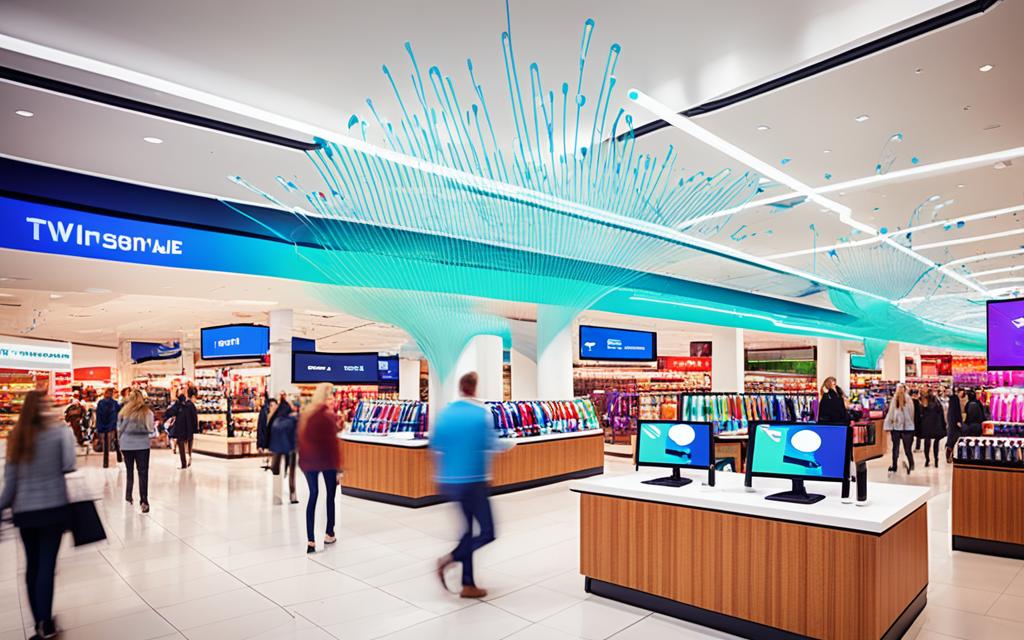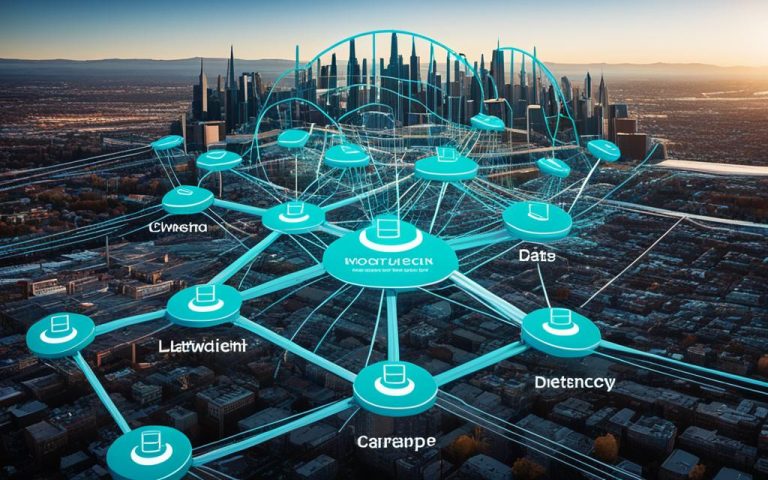The widespread use of smartphones and the Internet of Things (IoT) has revolutionized the retail industry, making Wi-Fi a crucial component in retail stores. Retailers recognize the need to maximize the value of their Wi-Fi infrastructure investment to enhance the shopping experience. However, they also face the challenge of balancing security with the flexibility of allowing various devices onto the network. With cyberattacks targeting retailers and the increasing need for connectivity, Wi-Fi has become a strategic imperative for thriving in the mobile age.
Wi-Fi in retail stores offers numerous benefits, including enabling in-store shoppers to access online information, search for products, and take advantage of promotional offers. It also allows retailers to engage with customers, provide personalized offers, and influence their purchasing decisions. Wi-Fi facilitates location-based advertisements, mobile payments, and access to loyalty programs. Furthermore, retailers can gather invaluable data on customer behavior, optimize staffing, and enhance customer relationship management.
The Benefits of Wi-Fi in Retail
Wi-Fi in retail stores offers numerous benefits. It allows in-store shoppers to access online information, search for products, and take advantage of promotional offers. The availability of Wi-Fi enables retailers to engage with customers, provide personalized offers, and influence their purchasing decisions. It also facilitates location-based advertisements, mobile payments, and access to loyalty programs.
Additionally, retailers can gather valuable data on customer behavior, optimize staffing, and enhance customer relationship management. By harnessing the power of Wi-Fi, retailers can create a seamless and connected shopping experience that enhances customer satisfaction and drives sales.
| Benefits of Wi-Fi in Retail |
|---|
| Access to online information |
| Search for products |
| Promotional offers |
| Engagement with customers |
| Personalized offers |
| Influence purchasing decisions |
| Location-based advertisements |
| Mobile payments |
| Access to loyalty programs |
| Gathering valuable customer data |
| Optimizing staffing |
| Enhancing customer relationship management |
Investing in a robust Wi-Fi infrastructure empowers retailers to deliver a seamless and personalized browsing experience to their customers, ultimately driving operational efficiency and increasing customer satisfaction.
Challenges of Deploying Wi-Fi in Retail Stores
Retailers in today’s digital age face numerous challenges when it comes to deploying Wi-Fi networks in their stores. These challenges encompass managing the RF space, ensuring optimal performance in multitenant environments, and addressing the critical issue of security concerns. With the growing reliance on mobile platforms and IoT devices, retailers must strike a delicate balance between granting network access to these devices while upholding robust security measures.
One of the key challenges retailers encounter is effectively managing the RF space. As more devices connect to the Wi-Fi network, the radio frequency (RF) environment can become congested, leading to reduced performance and slower data transfer rates. Retailers must implement strategic Wi-Fi planning and configuration to mitigate these issues and ensure smooth connectivity for customers.
In multitenant environments, where multiple retailers share the same physical space, it can be particularly challenging to deliver consistent Wi-Fi performance. With diverse network requirements, potential interference, and high-density foot traffic, retailers must deploy Wi-Fi solutions that can handle the complexities of these environments and provide seamless connectivity to customers and employees alike.
The ever-present concern of security looms large in the deployment of Wi-Fi networks. Retailers have a responsibility to protect their customers’ data and secure their networks against unauthorized access and potential cyber threats. The proliferation of mobile platforms and IoT devices only increases the surface area vulnerable to attacks. Retailers must implement robust security measures such as firewalls, intrusion prevention systems, and access controls to safeguard their Wi-Fi networks and customer data.
As the retail landscape continues to evolve and new technologies emerge, Wi-Fi solutions must adapt to handle an expanding array of traffic types. From smartphones and tablets to IoT devices and emerging technologies, retailers need a Wi-Fi infrastructure capable of serving the needs of both patrons and retailers. This adaptability ensures a seamless customer experience and empowers retailers to leverage the full potential of Wi-Fi technology.
Deploying Wi-Fi networks in retail stores poses unique challenges, from managing the RF space and addressing security concerns to ensuring optimal performance in multitenant environments. Striking the right balance between connectivity and security is essential for retailers looking to maximize the benefits of Wi-Fi technology.
To address these challenges, retailers can leverage comprehensive WLAN solutions that provide the necessary performance, security, and flexibility. Fortinet’s secure WLAN solution, for example, offers retailers a robust network infrastructure designed to secure and optimize Wi-Fi connectivity in retail environments.
Fortinet’s Secure WLAN Solution for Retail
Fortinet provides a secure WLAN solution tailored to the specific needs of retailers. This solution offers complete protection against wireless attacks, malware, and viruses while ensuring compliance with industry standards such as PCI. With Fortinet’s solution, retailers can transform the shopping experience and enhance brand loyalty through reliable and secure Wi-Fi connectivity.
The key components of Fortinet’s secure WLAN solution for retail include:
| Components | Features |
|---|---|
| Fortinet Access Points | Comprehensive coverage, ensuring reliable connectivity throughout the retail space. |
| FortiGate Network Security Platform | Firewall and intrusion prevention capabilities, safeguarding the Wi-Fi network and customer data. |
| FortiPresence Wi-Fi Presence Analytics | Provides valuable customer insights for targeted marketing and personalized offers. |
| FortiLink Network Access Control | Secures IoT devices and ensures authorized access to the network. |

Captivating a diverse customer base and delivering exceptional in-store experiences require retailers to overcome the challenges associated with deploying Wi-Fi networks. By implementing robust WLAN solutions like Fortinet’s, retailers can navigate the complexities of the retail environment, provide secure and reliable connectivity, and unlock the full potential of Wi-Fi technology.
Fortinet’s Secure WLAN Solution for Retail
Fortinet offers a secure WLAN solution that is specifically designed for retailers with multiple locations. Their comprehensive solution provides complete protection against wireless attacks, malware, and viruses, ensuring the security of retail networks. With Fortinet’s WLAN solution, retailers can transform the shopping experience, convert casual browsers into loyal customers, and enhance brand loyalty.
The core components of Fortinet’s WLAN solution include:
- Fortinet Access Points: These access points provide comprehensive coverage, ensuring that every corner of the retail store receives a strong and reliable Wi-Fi signal. Retailers can rest assured that their customers and employees have consistent access to a secure Wi-Fi network.
- FortiGate Network Security Platform: This platform acts as a firewall and intrusion prevention system, safeguarding the retail network from unauthorized access and potential threats. It ensures that all network traffic is monitored and secured, providing retailers with peace of mind.
- FortiPresence Wi-Fi Presence Analytics: This feature provides valuable customer insights by analyzing Wi-Fi network data. Retailers can gain a deep understanding of customer behavior, preferences, and shopping patterns, allowing them to make data-driven decisions and provide personalized experiences.
- FortiLink Network Access Control: As the number of IoT devices in retail environments continues to grow, securing these devices becomes critical. FortiLink network access control enables retailers to securely connect and manage IoT devices, ensuring that they do not pose a risk to the network.
Fortinet’s WLAN solution addresses the unique challenges faced by retailers in deploying and managing Wi-Fi networks. By providing robust security features, comprehensive coverage, and valuable analytics, Fortinet empowers retailers to leverage Wi-Fi technology to its full potential, creating a secure and engaging shopping environment for their customers.
To illustrate the benefits of Fortinet’s WLAN solution, the following table highlights key features and advantages:
| Benefits of Fortinet’s WLAN Solution for Retail | Description |
|---|---|
| Enhanced Security | Protection against wireless attacks, malware, and viruses to ensure a secure retail network |
| Improved Customer Experience | Transform the shopping experience with reliable, high-performance Wi-Fi and personalized services |
| Increased Customer Loyalty | Convert casual browsers into loyal customers by providing seamless connectivity and engaging experiences |
| Valuable Customer Insights | Analyze Wi-Fi network data to gain deep insights into customer behavior and preferences |
| Secure IoT Connectivity | Efficiently manage and secure IoT devices connected to the retail network for seamless operations |
The Role of Wi-Fi in Retail Customer Engagement
Wi-Fi plays a significant role in driving customer engagement in retail stores. By offering Wi-Fi access, retailers can create a better shopping experience, deliver personalized advertisements and offers, enable mobile payments, and enhance customer interaction.
One of the key benefits of Wi-Fi in retail stores is the ability to provide a seamless and connected shopping experience for customers. With Wi-Fi access, shoppers can easily access online information, search for products, and compare prices, enabling them to make well-informed purchase decisions. This convenience and accessibility enhance customer satisfaction and increase the likelihood of repeat visits and brand loyalty.
Wi-Fi also enables retailers to deliver personalized advertisements and offers to customers in real-time. By leveraging customer data and analytics, retailers can tailor their marketing messages to individual preferences and needs. This targeted approach not only boosts engagement but also increases the chances of conversions and sales.
Mobile payments have become increasingly popular in retail stores, and Wi-Fi plays a crucial role in enabling this payment method. With Wi-Fi access, customers can securely make transactions using their smartphones or mobile devices, providing a convenient and efficient payment option. This seamless and hassle-free payment experience further enhances customer satisfaction and drives engagement.
Wi-Fi-driven customer-engaging solutions, when implemented effectively, can transform retail stores into immersive and interactive environments, revolutionizing the overall shopping experience.
Moreover, Wi-Fi allows customers to share their in-store experiences on social media platforms, amplifying the brand’s visibility and reach. When customers connect to Wi-Fi in retail stores, they are likely to share their positive experiences with their followers, creating user-generated content that serves as free advertising for the brand. This organic online presence fosters brand advocacy and expands the retailer’s customer base.
Creating Effective Marketing Campaigns and Analyzing Customer Behavior
Implementing Wi-Fi-driven customer-engaging solutions empowers retailers to create and execute effective marketing campaigns. With access to customer data and insights, retailers can understand their customers’ preferences, behaviors, and demographics. This knowledge enables targeted marketing strategies that resonate with customers, resulting in higher engagement, increased footfall, and improved sales.
Wi-Fi also enables retailers to analyze customer behavior and gather valuable insights. By monitoring Wi-Fi usage patterns, retailers can understand customer movement within the store, identify popular areas, and optimize store layout and product placement. These insights improve operational efficiency and contribute to a richer multi-channel experience for customers.
Wi-Fi has become a vital tool in retail customer engagement, enabling retailers to provide a seamless shopping experience, deliver personalized offers, facilitate mobile payments, and gather valuable customer insights. By leveraging the power of Wi-Fi, retailers can create immersive and interactive environments that drive customer engagement, boost brand loyalty, and ultimately thrive in the competitive retail landscape.
Gap Inc.’s Experience with Wi-Fi Transformation
Gap Inc., a prominent retail brand, recognized the significance of enhancing their wireless network infrastructure to drive innovation and elevate the overall customer experience. To achieve this, they sought a WLAN solution that leveraged the scalability and resilience of the public cloud while offering full access to APIs for seamless integration with their in-house tools.
By redesigning their Wi-Fi network, Gap Inc. successfully implemented a high-performing Wi-Fi system that allowed for better visibility into network issues. This transformation enabled them to deploy game-changing services and improve overall productivity, ultimately driving profitability.
Benefits of Gap Inc.’s Wi-Fi Transformation
- Improved Customer Experience: With a robust Wi-Fi network, Gap Inc. enhanced the in-store connectivity for shoppers, allowing them to seamlessly access online information, browse products, and take advantage of promotional offers.
- Enhanced Operations: The revamped Wi-Fi infrastructure facilitated location-based advertisements, mobile payments, and access to loyalty programs, streamlining operations and boosting customer engagement.
- Better Network Management: Gap Inc.’s Wi-Fi transformation provided them with an improved understanding of network issues, enabling swift resolution and minimizing disruptions.
Gap Inc.’s experience clearly showcases the impact of Wi-Fi transformation in retail stores. With a focus on improving the wireless network, Gap Inc. successfully harnessed the power of technology to drive business growth and elevate the overall customer experience.
“Our Wi-Fi transformation has allowed us to provide customers with faster and more reliable connectivity, enhancing their shopping experience while driving our business forward.” – [Gap Inc. Executive]
To illustrate the impact of Gap Inc.’s Wi-Fi transformation, the following table highlights the key changes and outcomes:
| Wi-Fi Transformation Initiatives | Outcomes |
|---|---|
| Redesigned Wi-Fi network leveraging public cloud | Improved scalability and resilience |
| Full access to APIs for seamless integration | Enhanced integration with in-house tools |
| High-performing Wi-Fi network | Enhanced customer experience |
| Better visibility into network issues | Improved network management |
Gap Inc.’s Wi-Fi transformation serves as a testament to the importance of leveraging technology to optimize retail store operations and deliver an exceptional customer experience.
Conclusion
Wi-Fi has become a vital component in the retail industry, revolutionizing the way retailers engage with customers and operate their businesses. With the right Wi-Fi infrastructure in place, retailers can seamlessly connect their stores, provide in-store connectivity to customers, and enhance the overall shopping experience. By leveraging Wi-Fi, retailers can offer personalized offers and location-based advertisements, leading to increased customer engagement and sales.
Additionally, Wi-Fi empowers retailers to gather valuable customer insights, optimize staffing, and improve operational efficiency. The data collected through Wi-Fi networks can be analyzed to understand customer behavior, preferences, and trends, allowing retailers to make data-driven decisions and tailor their strategies accordingly.
To fully unleash the power of Wi-Fi in the retail industry, it is important for retailers to deploy secure and scalable connectivity solutions. Fortinet’s WLAN solution is an excellent example of a comprehensive solution that addresses the challenges of deploying Wi-Fi in retail stores. By implementing Fortinet’s solution, retailers can ensure the security of their networks, protect against cyber threats, and comply with industry standards while offering robust and reliable Wi-Fi connectivity to their customers.
FAQ
What is the role of Wi-Fi in the retail industry?
Wi-Fi plays a crucial role in the retail industry by enabling retailers to enhance the customer experience, streamline operations, and drive sales. It allows in-store shoppers to access online information, search for products, and take advantage of promotional offers. Wi-Fi also enables retailers to engage with customers, provide personalized offers, and influence their purchasing decisions.
What are the benefits of Wi-Fi in retail stores?
Wi-Fi in retail stores offers numerous benefits. It allows customers to access online information, search for products, and take advantage of promotional offers. Wi-Fi also enables retailers to engage with customers, provide personalized offers, and influence their purchasing decisions. Additionally, it facilitates location-based advertisements, mobile payments, and access to loyalty programs. It also allows retailers to gather valuable data on customer behavior, optimize staffing, and enhance customer relationship management.
What challenges do retailers face when deploying Wi-Fi networks in their stores?
Retailers face several challenges when deploying Wi-Fi networks in their stores. These challenges include managing the RF space, ensuring performance in multitenant environments, and addressing security concerns. They also need to allow various devices onto their networks while maintaining security. Wi-Fi solutions must adapt to handle a wide range of traffic types and serve the needs of both patrons and retailers as new technologies are introduced into the retail network.
What is Fortinet’s secure WLAN solution for retail?
Fortinet offers a secure WLAN solution ideal for retailers with multiple locations. Their solution provides complete protection against wireless attacks, malware, and viruses while ensuring compliance with industry standards like PCI. It includes Fortinet access points for comprehensive coverage, a FortiGate network security platform for firewall and intrusion prevention, FortiPresence Wi-Fi presence analytics for customer insights, and FortiLink network access control for securing IoT devices.
How does Wi-Fi enhance customer engagement in retail stores?
Wi-Fi in retail stores allows retailers to provide a better shopping experience, offer personalized advertisements and offers, enable mobile payments, and enhance customer interaction. It also allows shoppers to share their in-store experiences on social media platforms, increasing brand visibility. With Wi-Fi-driven customer-engaging solutions in place, retailers can succeed in creating effective marketing campaigns, improving footfall, analyzing customer behavior, and delivering a richer multi-channel experience.
What is Gap Inc.’s experience with Wi-Fi transformation?
Gap Inc. recognized the need to improve the wireless network in their stores to support innovation and enhance the customer experience. By redesigning their Wi-Fi network, Gap Inc. was able to provide high-performing Wi-Fi and better visibility into network issues. The transformation allowed them to deploy game-changing services, improve productivity, and drive profitability.
How can retailers leverage Wi-Fi for business success?
Implementing a secure and scalable WLAN solution, like Fortinet’s, can help retailers overcome the challenges of deploying Wi-Fi in their stores and leverage its full potential for business success. Wi-Fi infrastructure enables retailers to provide in-store connectivity, personalized offers, and location-based advertisements. It also allows them to gather valuable customer insights, optimize staffing, and improve customer engagement.



















